Russia marks 50 years since Gagarin triumph
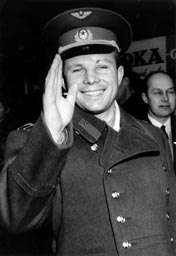
Half a century ago, a Russian carpenter's son named Yuri Gagarin became the first man in space, carving an indelible mark in human history and scoring the greatest Soviet Cold War success.
The 27-year-old's 108-minute flight on April 12, 1961 is still remembered in Russia even after the collapse of the Soviet Union as its greatest national achievement. His death in a plane crash seven years later only added to his mythical status.
Gagarin's safe return to earth in central Russia -- where he was famously given bread and milk by an astonished grandmother -- ensured he would live the rest of his life as a legend in Russia and abroad.
Hundreds of thousands flooded the streets of Moscow when news broke of his triumph, which confirmed the Soviet Union's undisputed supremacy in the space race, a lead it would keep for eight years until Americans walked on the moon.
The other-worldly allure of Gagarin is exemplified by the 40-metre-high (130-feet) titanium monument that still bears down on Moscow, his arms outstretched like a bionic superman and apparently preparing to shoot upwards into the sky.
Soviet leader Nikita Khrushchev seized on the propaganda value of Gagarin's coup in beating the United States into space, sending him on "missions of peace" around the world, to meet figures including Britain's Queen.
"This achievement exemplifies the genius of the Soviet people and the strong force of socialism," the Kremlin crowed in a statement at the time.
The United States could only respond more modestly, putting Alan Shepherd into a short sub-orbital flight on May 5, 1961. The first US orbital flight by John Glenn came almost one year after Gagarin on February 20, 1962.
Russia's modern day leaders are also not expected to shy away from using the anniversary on Tuesday to remind Russians and the world of its past achievements and that it remains a great power on the global stage.
Gagarin was confirmed as pilot just four days before launch, a choice which propelled him to stardom and the reserve Gherman Titov, who would later become the second Soviet cosmonaut in space, to relative obscurity.
His name also overshadows the mastermind of the mission, Sergei Korolev, who designed the equipment that took Gagarin to space yet whose role in the space programme was kept from the public as a state secret until his death in 1966.
An extraordinary figure, Korolev survived imprisonment in the gulag in the Stalin purges to work tirelessly on the space programme. He died while working on a massive rocket, the N1, which he hoped would take Soviets to the moon.
When Gagarin was killed, a driving licence, 40 rubles and a photograph of Korolev were found in his pocket.
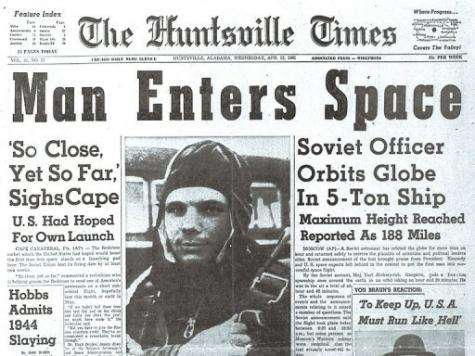
Few lives in modern history have been the subject of so much mythologising as that of Gagarin, with every aspect of his mission and subsequent life pored over in detail.
He took off at 9:07 am Moscow time from the Baikonur cosmodrome whose location in the south of Kazakhstan was tightly-kept secret.
He ejected and parachuted down to earth in the Saratov region of central Russia. The first people to make contact with the newly returned cosmonaut were peasant Anna Takhtarova and her four-year-old granddaughter Margarita.
"I looked round and saw this orange monster with a huge head coming towards us," Margarita recalled in an interview with tabloid daily Komsomolskaya Pravda.
"Grandma helped Yuri Gagarin take off his helmet -- she pressed some kind of button. And when we saw a smiling face in front of us we understood that it was a human being in front of us."
For years, the Soviet Union concealed that Gagarin had parachuted to Earth since world aeronautics rules at the time stipulated that a person would have to land his craft on earth for the orbit to be considered valid.
More sinister is the intrigue surrounding Gagarin's death on March 27, 1968, when the Mig fighter carrying him and instructor Vladimir Seryogin crashed in the Vladimir region outside Moscow while on a training flight.
The crash was never properly explained. But different commissions have said it may have been the result of a rapid change in height to avoid an object, interference from another craft, or oxygen deprivation in the cabin
The disaster has been scrutinized by conspiracy theorists who have alleged the crash could have been triggered by his co-pilot or even organised by the new Soviet leadership of Leonid Brezhnev, jealous of his personal magnetism.
The deaths of Korolev and Gagarin within just over two years also coincided with the end of the Soviet Union's lead in the space race that had started with the launch of the first orbiting satellite into space, Sputnik-1 in 1957.
Just over a year after Gagarin was killed, on July 20, 1969, US astronaut Neil Armstrong would take the first human steps on the moon.
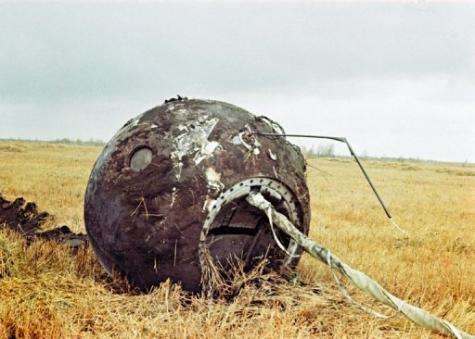
Gagarin's 108 minute voyage to immortality
Let's go!" With these words Yuri Gagarin on April 12, 1961 blasted-off on the Vostok rocket that took him into orbit as the first man in space.
There was no countdown, American-style, at the Baikonur cosmodrome, just tense exchanges between Gagarin and the father of the Soviet space programme, Sergei Korolev, that occasionally lapsed into banter to break the tension.
Here is a chronology of the extraordinary days in April 1961 and moments on April 12 that saw the Soviet Union write a new chapter in human history.
April 9 -- Yuri Gagarin is officially chosen for the mission scheduled for April 12. His reserve is named as Gherman Titov who would later on August 6 became the second man in space with a day-long flight.
April 10 -- Staying at the Baikonur cosmodrome ahead of his launch, Gagarin writes to his wife to bring up their two daughters as "worthy members of the new Communist society" should anything happen to him.
April 11 -- Gagarin and Titov spend the night in a small wooden hut in Baikonur. "I'm leaving tomorrow and I don't even believe it myself," he writes.
April 12
5:30 am Moscow time: The two cosmonauts are awoken. After a medical examination and a light meal they climb into their orange space suits and their helmet. Gagarin does not shave, respecting the superstition of Soviet pilots before an important flight.
5:45 am: Gagarin and Titov are taken towards the launch site in a blue bus. It stops on the way for Gagarin to take a bathroom break, a halt that has now become a ritual tradition for other launches.
6:50 am: Gagarin gets out of the bus close to the launch pad. He is embraced by Korolev. A worker writes the letters "USSR" in Russian on his helmet.
7:07 am: Gagarin boards his Vostok-1 capsule. Gagarin awaits the end of preparations singing popular songs and joking with his colleagues over the radio. Famously, Korolev assures him he is well supplied with food and warns him he may get fat.
At the last moment, the technicians carry out a repair to seal number one which had turned out not to be completely hermetically sealed.
9:07 am: The rocket fires. Gagarin utters the famous words "Let's go" as his pulse reaches 150 and Vostok blasts off.
9:09 am: Gagarin is silent for several minutes, as his body is subjected to unprecedented G-forces.
9:12 am: Gagarin speaks again over the radio "I see the earth, it's magnificent".
10:02 am: Soviet official radio solemnly announces the news to the people.
10:09 am: Gagarin says over the radio he has returned from under the Earth's shadow.
10:25 am: The spaceship returns into the earth's atmosphere, its retrorockets carry out braking but the craft starts spinning.
10:35 am: The craft stabilises.
10:49 am: Gagarin ejects at an altitude of 7,000 metres, as planned.
10:55 am: The craft itself lands with the help of a parachute into a field close to Saratov in the Volga region.
10:57 am: Gagarin lands by parachute some three kilometres (two miles) distant. The first people he sees are a peasant woman and her granddaughter whom he reassures that he is not an alien.
A helicopter then arrives to take the triumphant cosmonaut to the nearby city of Engels, where he receives a telegram of congratulation from Soviet leader Nikita Khrushchev. Gagarin also speaks to his wife, Valentina.
April 13 -- Gagarin recuperates at an elite dacha in the Volga city of Kuibyshev, today known as Samara.
April 14
-- Gagarin lands at Moscow's Vnukovo airport. Thousands of Russians take to the streets decked with flowers and posters to give him a triumphant welcome which culminates in a drive in an open top car on Red Square.
-- Standing on Lenin's Mausoleum, Gagarin reports back to Khrushchev who then breaks with formalities by embracing and kissing the cosmonaut. He gives a speech which is broadcast by all Soviet radio and television.
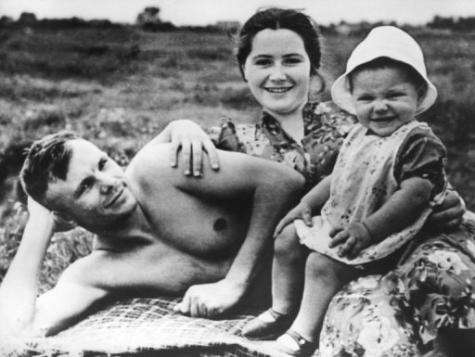
Gagarin, a poster boy for Soviet space travel
The first cosmonaut Yuri Gagarin, a carpenter's son with a military bearing and an easy smile, was the ideal candidate for the Soviet authorities to send on the pioneering flight.
Today he is one of the few idols of the Communist era whose popularity has not waned since the fall of the Soviet Union.
Last year he topped a poll of the most iconic national figures of the 20th century, with his popularity highest among those aged 18-24.
Gagarin's peasant origins undoubtedly worked in his favour in the selection process for the first cosmonaut, between him and his closest rival, Gherman Titov, who came from an educated family of teachers.
He was born in 1934 to a couple who worked at a collective farm and had three other children. In 1941, the Nazis occupied their village close to Smolensk in western Russia, and he was unable to go to school until 1943.
After completing seven years of schooling, he trained as a metalworker and was seemingly destined for a career in factories.
"His path was similar to that of millions of his fellow citizens," said Lev Danilkin, the author of a recent biography of the cosmonaut.
In a speech later, Gagarin called himself "a simple Soviet man".
Passionate about aeroplanes from childhood, Gagarin joined a flying club at the age of 20 and later trained as a fighter pilot at a military training school in the town of Orenburg in the Ural mountains.
One day in 1959, the call went out for airforce volunteers to train to fly a "new type of apparatus" and it turned out that Gagarin's small stature, around 1.60 metres (five foot three inches), was an advantage.
The 20 volunteers began year-long secret training in Moscow and the surrounding region. They were later whittled down to 12 and then to six, including Gagarin.
The fair-haired young man with blue eyes and an open smile had the looks of a poster boy, but he also won the liking of his colleagues and especially of Sergei Korolev, the brilliant mastermind of the space programme.
"Gagarin was not a leader, but he was friends with everyone and Korolev treated him as if he were his own son," cosmonaut Boris Volynov, a contemporary of Gagarin, remembered.
In 1961, Gagarin was picked for the first manned mission to space, with the date fixed for April 12.
At 27, he was already married to a nurse called Valentina, who was pregnant with their second daughter.
The mission was perilous for Gagarin. Out of 48 dogs sent into orbit, 20 had died.
Nevertheless "everyone dreamed of being in his place", Volynov told AFP.
"Yuri was chosen for his personal qualities. He was very close to the people."
In a letter written to his wife before the flight and published this year, Gagarin said he believed the spaceship was reliable but added a more emotional note.
"If something happens, you should know everything to the end. I have lived so far honestly, truthfully and to the benefit of the people, even if it was a small one."
He quoted famed Soviet pilot Valery Chkalov as saying that "if you are going to be at all, then be first".
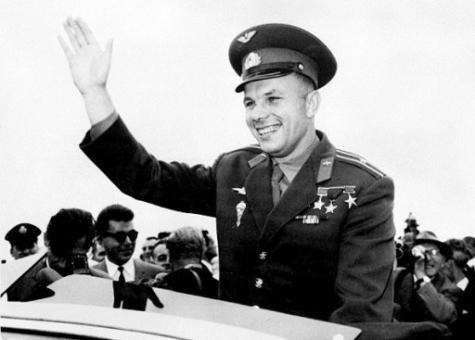
When he returned to Earth and worldwide acclaim, Gagarin carried out his role with grace, witnesses said, recalling his disarming simplicity.
Three months after the flight, he dined with Queen Elizabeth II and was said to have admitted candidly that he did not know which fork to use.
"Gagarin was the most successful propaganda project for the Soviets," said his biographer Danilkin.
Now enjoying the privileges of the Soviet elite, Gagarin shared them with his friends, spending hours on the telephone to get hold of medicine, a hospital bed or a ticket to the Bolshoi for his many friends, Volynov recalled.
That's not to say there were not any incidents, with the cosmonauts the same age as footballers.
In 1961, Gagarin jumped off a balcony, scarring his face, after his wife apparently discovered him in another woman's hotel room, Nikolai Kamanin, who was in charge of cosmonaut training, wrote in published diaries.
Television footage from a few years after his space flight shows he had put on weight and appeared out of condition.
Kamanin wrote in his diaries that Gagarin spent too much time at receptions and that everyone wanted to drink a toast with him.
"Everyone wanted to drink with Gagarin 'for friendship', 'for love' and for a thousand other reasons, and to drink to the bottom of the glass," he wrote in 1968.
His role completed, Gagarin was unable to develop as a cosmonaut or pilot. He was too precious to the Soviet publicity drive to risk any more space missions and he had to beg the authorities to lift his flight ban.
In 1968, Gagarin was allowed to return to flying, initially with a co-pilot.
On March 27, 1968, while flying a small training plane, he crashed north-east of Moscow in an accident whose reasons are still unclear. The file on the investigation remains a state secret.
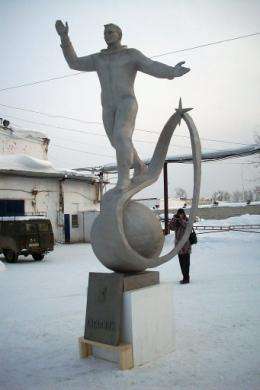
Key dates in the history of space exploration
Following are key dates in the history of space travel and exploration, 50 years after Soviet cosmonaut Yury Gagarin became the first man in space:
1957
October: USSR launches first satellite Sputnik 1.
November 3: Russian dog Laika becomes first live animal in space but dies aboard Sputnik 2.
1958
October: American space agency National Aeronautics and Space Administration (NASA) created.
1961
April: Gagarin becomes first man in space, completing a single, 108-minute orbit aboard Vostok 1.
May: US President John Kennedy launches the Apollo programme which foresees a man on the moon by the end of the decade. American Alan Shepard carries out a 15-minute space flight aboard Mercury.
1962
February: American John Glenn completes the first three orbits of the Earth.
August: US launches a probe to Venus, USSR fires a probe to Mars in November.
1963
June: First space flight by a woman, Soviet cosmonaut Valentina Tereshkova.
1965
March: Cosmonaut Aleksei Leonov undertakes first spacewalk during a 26-hour flight.
1967
January: Launchpad blaze kills all three astronauts aboard Apollo 1. Soviet cosmonaut Vladimir Komarov killed when Soyuz 1 parachute fails in April.
1969
July: US astronauts Neil Armstrong, then Edwin "Buzz" Aldrin (Apollo 11) become first men to set foot on the Moon.
1971
April: USSR launches first orbital space station, Salyut 1.
June: Three cosmonauts on Soyuz 11 die during descent of their module.
1975
May: European Space Agency created.
July: A US Apollo spacecraft docks with a Soviet Soyuz spacecraft while in Earth orbit.
1979
December: Europe becomes a space power with the launch of the Ariane rocket.
1981
April: Maiden voyage of the US space shuttle Columbia, the first reusable manned spacecraft. It is followed later by Challenger, Discovery, Atlantis and Endeavour.
1986
January: Challenger explodes on liftoff, killing all seven astronauts.
1990
April: Launch of of the Hubble Space Telescope, a joint venture between NASA and the European Space Agency.
1998
November: Start of the contruction of the International Space Station (ISS), which is inhabited in late 2000.
2001
April: US millionaire Dennis Tito becomes the world's first space tourist.
2003
February: Shuttle Columbia disintegrates over Texas upon reentry killing seven astronaunts.
October: China launches the Chang'e I satellite, the nation's first lunar orbiter. In September 2008 Chinese astronaut Zhai Zhigang aboard the Shenzhou VII successfully completes his country's first ever space walk.
2004
September: British airline magnate Richard Branson announces a plan for the world's first commercial space flights.
2008
October: India's first lunar mission blasts off from the national space centre on the southeastern coast.
2009
February: Iran launches its first domestically manufactured satellite into orbit. A year later it sends animals into space.
2010
February: US President Barack Obama scraps plans to return Americans to the moon and to conquer Mars.
2011
February: Shuttle Discovery lands back on Earth after its final space flight before retirement. After the last journeys of Endeavour and Atlantis, the US will depend totally on Russia's Soyuz to go to space.
(c) 2011 AFP



















